

CienciaXplora sur Twitter : "Así de rápido se mueven los electrones en una molécula vital. Observado el movimiento ultrarrápido de los electrones en una molécula vital. Científicos de la Universidad Autónoma de Madrid (UAM) han reportado esta semana en la revista Science la primera evidencia experimental de la migración de carga ultrarrápida (dinámica electrónica a escala de attosegundos) en una molécula de interés biológico: el aminoácido fenilalanina.
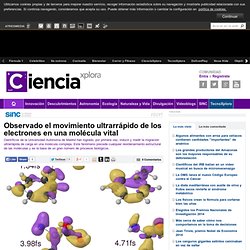
La migración de carga fue inducida por un pulso de luz extremadamente corto, de duración de attosegundos, y fue detectada iluminando la molécula con un segundo pulso de luz, pocos attosegundos después. Un attosegundo es la millonésima parte de la millonésima parte de la millonésima parte de un segundo, o lo que es lo mismo: la trillonésima parte de un segundo –en un segundo caben tantos attosegundos como segundos caben en 100.000 millones de años–.
Dinámica electrónica ultrarápida Los pulsos de femtosegundos han contribuido, y siguen contribuyendo, a la investigación y comprensión de numerosas reacciones, muchas de ellas implicadas en importantes procesos biológicos. Laura Morrón sur Twitter : "Distracciones en el laboratorio...
Ragbag. Fuctional. Ablation of the Id2 Gene Results in Altered Circadian Feeding Behavior, and Sex-Specific Enhancement of Insulin Sensitivity and Elevated Glucose Uptake in Skeletal Muscle and Brown Adipose Tissue. Inhibitor of DNA binding 2 (ID2) is a helix-loop-helix transcriptional repressor rhythmically expressed in many adult tissues.
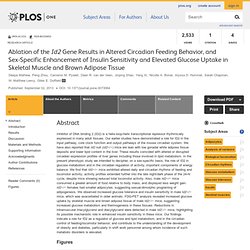
Our earlier studies have demonstrated a role for ID2 in the input pathway, core clock function and output pathways of the mouse circadian system. We have also reported that Id2 null (Id2−/−) mice are lean with low gonadal white adipose tissue deposits and lower lipid content in the liver. These results coincided with altered or disrupted circadian expression profiles of liver genes including those involved in lipid metabolism. In the present phenotypic study we intended to decipher, on a sex-specific basis, the role of ID2 in glucose metabolism and in the circadian regulation of activity, important components of energy balance.
Figures Editor: Paul A. Received: April 26, 2013; Accepted: July 15, 2013; Published: September 2, 2013 Copyright: © 2013 Mathew et al. Born this way? An evolutionary view of ‘gay genes’ The claim that homosexual men share a “gay gene” created a furore in the 1990s.
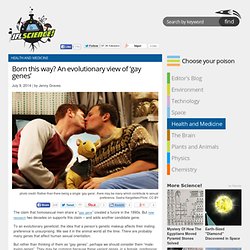
But new research two decades on supports this claim – and adds another candidate gene. To an evolutionary geneticist, the idea that a person’s genetic makeup affects their mating preference is unsurprising. Transplanting gene into injured hearts creates biological pacemakers. Cardiologists at the Cedars-Sinai Heart Institute have developed a minimally invasive gene transplant procedure that changes unspecialized heart cells into "biological pacemaker" cells that keep the heart steadily beating.
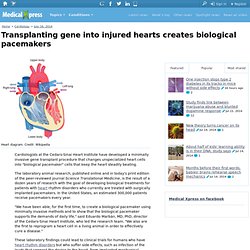
The laboratory animal research, published online and in today's print edition of the peer-reviewed journal Science Translational Medicine, is the result of a dozen years of research with the goal of developing biological treatments for patients with heart rhythm disorders who currently are treated with surgically implanted pacemakers. In the United States, an estimated 300,000 patients receive pacemakers every year. "We have been able, for the first time, to create a biological pacemaker using minimally invasive methods and to show that the biological pacemaker supports the demands of daily life," said Eduardo Marbán, MD, PhD, director of the Cedars-Sinai Heart Institute, who led the research team. Genome-wide analysis reveals genetic similarities among friends: Study finds truth to 'friends are the family you choose'
If you consider your friends family, you may be on to something.

A study from the University of California, San Diego, and Yale University finds that friends who are not biologically related still resemble each other genetically. Published in the Proceedings of the National Academy of Sciences, the study is coauthored by James Fowler, professor of medical genetics and political science at UC San Diego, and Nicholas Christakis, professor of sociology, evolutionary biology, and medicine at Yale.
Brains, Genes And Chemical Imbalances – How Explanations Of Mental Illness Affect Stigma. Depression, schizophrenia and other psychiatric conditions are increasingly linked to abnormalities in the brain and in our genes.

Many professionals believe these developments hold the key to better treatments and their enthusiasm has spread. The public now endorses biogenetic (biological and genetic) explanations for mental health problems much more than in previous decades. Enhanced Chromatin Dynamics by FACT Promotes Transcriptional Restart after UV-Induced DNA Damage. To view the full text, please login as a subscribed user or purchase a subscription.

Click here to view the full text on ScienceDirect.
Chemistry On The End of DNA. In the Pipeline: We chemists have always looked at the chemical machinery of living systems with a sense of awe.

A billion years of ruthless pruning (work, or die) have left us with some bizarrely efficient molecular catalysts, the enzymes that casually make and break bonds with a grace and elegance that our own techniques have trouble even approaching. The systems around DNA replication are particularly interesting, since that's one of the parts you'd expect to be under the most selection pressure (every time a cell divides, things had better work). New technique maps life's effects on our DNA: Powerful single-cell technique to study environmental effects on DNA. Researchers at the BBSRC-funded Babraham Institute, in collaboration with the Wellcome Trust Sanger Institute Single Cell Genomics Centre, have developed a powerful new single-cell technique to help investigate how the environment affects our development and the traits we inherit from our parents.

The technique can be used to map all of the 'epigenetic marks' on the DNA within a single cell. This single-cell approach will boost understanding of embryonic development, could enhance clinical applications like cancer therapy and fertility treatments, and has the potential to reduce the number of mice currently needed for this research. Investigadores españoles actualizan el genoma humano. 'X-shape' not true picture of chromosome structure, new imaging technique reveals. A new method for visualising chromosomes is painting a truer picture of their shape, which is rarely like the X-shaped blob of DNA most of us are familiar with.
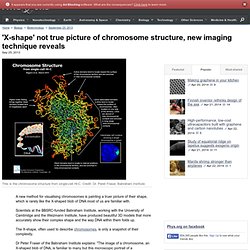
Scientists at the BBSRC-funded Babraham Institute, working with the University of Cambridge and the Weizmann Institute, have produced beautiful 3D models that more accurately show their complex shape and the way DNA within them folds up.